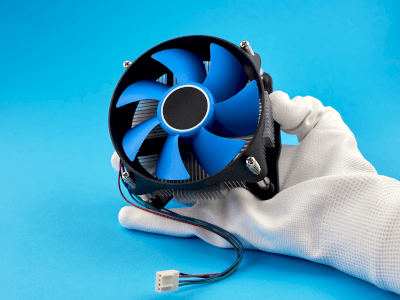What Is a CPU Cooler?

A CPU cooler is a component used to cool the CPU of a computer, such as a PC, etc. Since the CPU generates heat during operation, problems such as thermal runaway, in which the semiconductors inside the CPU do not operate properly, can occur if the CPU is not cooled appropriately. For this reason, CPU coolers are installed according to the power consumption of the CPU.
There are two main types of CPU coolers: air-cooled and water-cooled. Most of the CPU coolers in PCs on the market are air-cooled, while water-cooled coolers are often used in home-built PCs.
Usage of CPU Coolers
CPU coolers are used by attaching them to the CPU. It is installed in most models of desktop and notebook PCs on the market. The sound of the wind when the computer is in use is due to the electric fan operating to release the heat generated by the CPU into the atmosphere.
Other than commercial PCs, CPU coolers are sold separately to build your own PC.
Principle of CPU Cooler
The components of an air-cooled CPU cooler are a base plate, a heat pipe, a heat sink, and an electric fan. The heat path from the CPU to the air is in the order of CPU → base plate → heat pipe → heat sink → air. Heat pipes and electric fans are sometimes omitted.
The materials and structure of CPU coolers are designed to dissipate heat efficiently. Copper and aluminum alloys are used as materials for the components in consideration of thermal conductivity and heat transfer coefficient to the air. In order to efficiently transfer heat from the CPU to the base plate, thermal conduction grease is applied to the contact surfaces.
To dissipate heat from the heat sink to the air, many CPU coolers use an electric fan to generate a forced airflow. The electric fan’s airflow is used to cool the heatsink and other elements on the motherboard (board), such as memory. The airflow inside the case is also designed with airflow considerations in mind, as the air that the heat sinks have heated must be discharged smoothly to the outside of the computer case.
The size of the heat sink is essential to increase the heat dissipation capacity of the air-cooled system. A large heat sink is required to cool a CPU with high power consumption, but the installation space in the case limits the size of the heat sink.
The components of a water-cooled CPU cooler can be thought of as replacing the heat pipes that play the role of heat conduction in air-cooled systems with cooling water hoses and the heat sinks for dissipating heat with radiators. Since radiators can be installed outside the case, they can be easily increased in size, and cooling capacity can be easily improved. However, there is a risk of failure due to cooling water leakage.